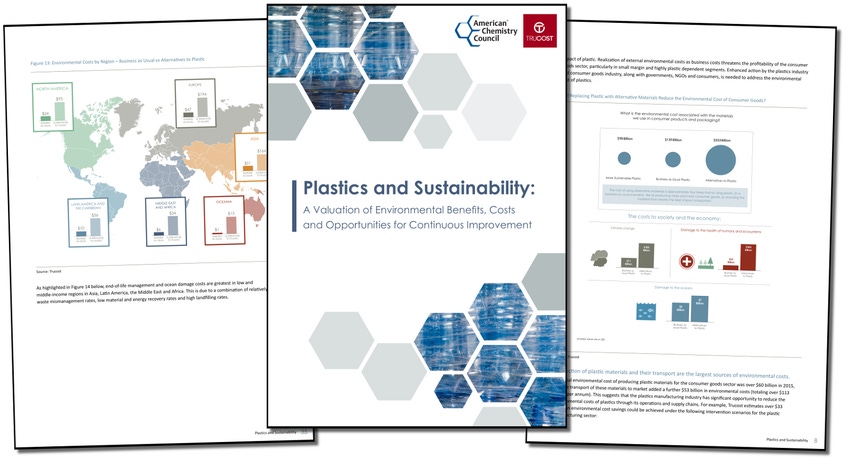Plastic packaging scores an environmental win

What’s the net environmental cost of plastic packaging and how does it compare to other packaging? New research explores the material’s “natural capital” value and concludes that its eco-efficiencies make good business sense.
Natural capital is “the finite stock of natural assets (air, water, land) from which goods and services flow to benefit society and the economy. It is made up of ecosystems, and non-renewable deposits of fossil fuels and minerals.” It was coined by British economist E.F. Schumacher in his 1973 book “Small Is Beautiful: A Study of Economics As If People Mattered.”
Natural capital is used by the global economy to produce goods and services: Oil is extracted from the ground to power industry; trees are harvested for pulp and wood; cattle is bred and raised for human consumption. What are the social and environmental costs associated with natural capital consumption, like greenhouse gas emissions and waste management—and who is to pay the price?
The natural capital costs of almost every product and service our economy produces and consumes is not accounted for in corporate finance, nor is it factored into the market price for a consumer product good or service. Trucost—a company working to change that—applies natural capital valuation techniques to business operations to allow corporate entities measure environmental impacts in monetary terms. The intent is that these environmental costs can be factored into business decision-making and investment, policy setting and in weighing the tradeoffs between implied costs and benefits of economic activity.
Trucost developed a methodology for valuing the environmental cost of plastic used in the consumer goods sector for the United Nations Environment Program in 2014. Titled Valuing Plastic,Trucost identified $75 billion in annual natural capital costs associated with plastic use by the consumer goods sector.
Is $75 billion in natural capital costs associated with plastic use in the consumer goods sector a lot? Trucost’s 2016 report for the American Chemistry Council, Plastics and Sustainability, works to place this valuation within a larger context by analyzing the natural capital costs associated with the consumer goods sector if plastics were replaced with alternative materials.
Trucost finds—in accordance with recent studies by Franklin Associates and Denstatt—that a move away from plastics comes at an even higher net environmental cost, due primarily to the material efficiency of plastics versus the alternative materials intended to replace it.
Specifically, Trucost’s natural capital valuation of plastics versus its alternatives in the consumer goods sector demonstrates that substituting plastics with other materials that perform the same function comes at a net environmental cost of about 4 to 1. While plastics consume a lot of natural capital during production and transport to market compared to alternatives, the inherent material efficiency of plastic allows it to perform the same function with less mass. Trucost provides insight into the environmental hot spots of plastic use in the consumer goods sector, demonstrating that the largest return on investment for natural capital consumption occurs upstream during resin processing and transport.
Among the key questions the report explores are:
• What is the global environmental cost of plastic use in the consumer goods sector and how would this change if plastic were replaced with alternatives?
• What is the impact on oceans for plastics and its alternatives?
• Which sectors have the greatest environmental cost?
• What are the most important environmental costs and where are they concentrated in the value chain?
Consult the free report for a full analysis.

Chandler Slavin is the sustainability coordinator and marketing manager at custom thermoforming company Dordan Manufacturing. Privately held and family owned and operated since 1962, Dordan is an engineering-based designer and manufacturer of plastic clamshells, blisters, trays and thermoformed components. Follow Slavin on Twitter @DordanMfg.
*****************************************************************************
About the Author(s)
You May Also Like




